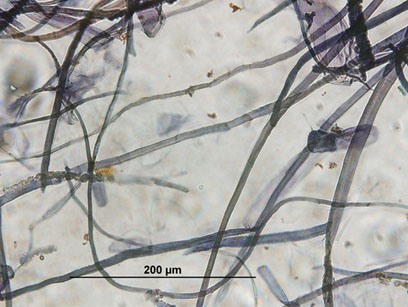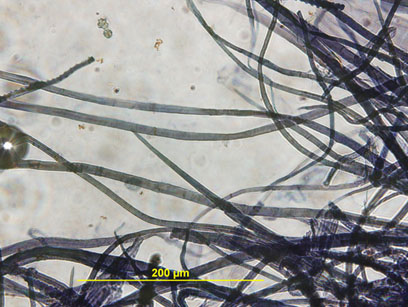Blue Sandalwood
| Common Name | Blue Sandalwood | Japanese Name | Seitan |
|---|---|---|---|
| Scientific Name | Ulmus Pteroceltis Tatarinowii Maxim | ||
| Fibre Length | Average 2.5mm (800µm-4mm) | Fibre Width | Average 12µm (4-25µm) |
| Fibre Ends | Variable | Cross-Marking | Strong |
| Associated Cells | |||
| Herzberg Colour | Gray/Blue | Graff 'C' Colour | Gray/Blue |
Notes:
Originating in Anhui province, China, this fibre was traditionally the principle ingrediant in Senshi (Xuanzhi in Chinese) papers used for calligraphy, painting and printing. This plant will not grow in Japan, so southern China remains its main source. Senshi papers are generally smooth, white and absorb the ink well, displaying the tone of the ink, as well as having smooth edges when the ink bleeds. Senshi papers are rarely ever made of pure Blue Sandalwood fibres, instead they are usually manufactured with rice, bamboo or other fibres. From anecdotal accounts Blue Sandalwood fibres are being substitued by cheaper fibres in contemporary Senshi paper manufacture. During the mid-Qing dynasty imitation Senshi papers came to be produced using bleached fibres of other fibres such as bamboo[25]. The most famous of the Senshi manufacturers in China is the Red Star brand.
Traditional Processing of Blue Sandalwood Fibres
The Blue Sandalwood is grown from cuttings, and after two years the branches are cut and tied into bundles. The bundles are then steamed for several hours, so the bark can easily be removed from the wood. The bark is then left to soak for several months, so that the dark outer bark can easily be removed from the white inner bark. The fibres are then given a mild alkali bath and are then either sun bleached [19] , or a sodium hypochloride bleach is used to speed up the process [7].
Hillary Mullock,[19], found that Blue Sandalwood fibres were up to 800µm in length, and 16µm wide with horizontal markings at irregular intervals. While Fei Wen Tsai found the fibres to be between 1.66-9.94mm in length, and 8.3-25.4µm in width. Petukhova et al [22] found the Blue Sandalwood fibres to have rounded polygonal nodes, to have a thick wall, a lumen, and to have square shaped fibre end. When stained with Dyeing Solution C the fibres are recorded as being light reddish purple to greyish purple [22].
In my investigation I used a sample of Red-Star Senshi paper made in the early 80's. Anecdotally, I had been told that Senshi papers produced since the 90's have been using less and less Blue Sandalwood fibres, substituting other bast fibres instead. The sample I used contained Paper-mulberry which stained red with a blue lumen, as well as rice straw, staining blue. The Blue Sandalwood fibres stained light blue gray to a purple gray, often with reddish purple striations, with occaisonal nodes and dislocations, and pitting, especially around nodes and dislocations (See Image 1 where Blue Sandalwood fibres are seen with Paper-mulberry fibres). Fibre lengths ranged from between 800µm to approximately 4mm, while fibre width was between 8-25µm. Fibre ends were variable, often broken, while many had pointed ends. I found it difficult to differentiate associated cells of the Blue Sandalwood from other fibres added to the paper, such as Paper-mulberry, Rice and Bamboo.
| Image 1 | Image 2 |
|---|---|
 |
 |
For information about this page, contact: Travis Taylor
Contact email address: travtora@gmail.com
Centre homepage: www.culturalconservation.unimelb.edu.au
Page last modified:
This page, its contents and style, are the responsibility of the author and do not represent the views, policies or opinions of The University of Melbourne.